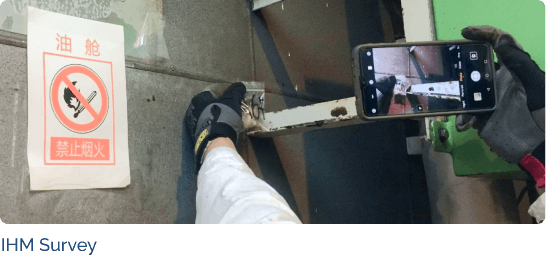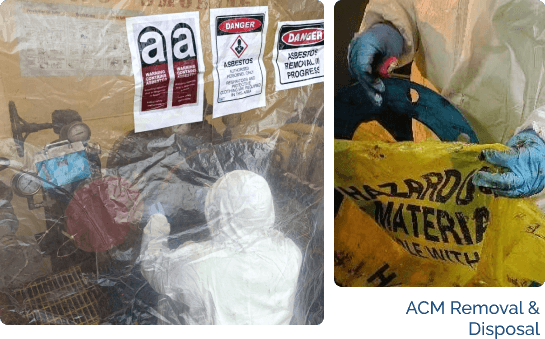Inventory of Hazardous Materials (IHM)
Certified by all major IACS Members, Liberian Registry & Marshall Island
ABS / BV / NK / DNV / CCS / LR / KR / IRS / RINA

ABS / BV / NK / DNV / CCS / LR / KR / IRS / RINA

This compliance with regulations is crucial for both safety and legal reasons. Ship owners today have no other choice but to proactively address IHM implementation and maintenance to ensure they meet international regulations in a globalized world.
The IHM document shall be properly maintained and updated throughout the operational life of the ship.
Section 5.3 of the Hong Kong Convention
Section 5.6 of European Ship Recycling Regulation
IHM was originally introduced to improve the handling and disposal of hazardous substances during ethical recycling of ships. However, since the presence of these hazardous and potentially life-threatening materials poses a threat to the crew and marine life during the ship’s operation, nowadays, the IHM is a crucial and mandated step.
Ship owners risk facing significant liabilities if information of the inventory of these hazardous materials, including the types, quantities, and locations are not always up to date.
All ships exceeding 500 gross tons must possess a valid and certified IHM when entering EU ports or anchorages.
Non-EU flagged vessels can comply with the HKC's IHM regulations to obtain EU SRR certification.
There are two regulations that govern the requirements for inventory of hazardous materials:
Hong Kong International Convention for the Safe and Environmentally Sound Recycling of Ships, 2009 SR/CONF/45 (HKC), which will enter into force in 26th June 2025.
The EU Regulation on Ship Recycling (EU) No. 1257/2013 (EU SRR), which is in force since 31 December 2020.
With the upcoming enforcement of the Hong Kong Convention (HKC) and existing EU Ship Recycling Regulation (EU SRR), IHM (Inventory of Hazardous Materials) is mandatory for ships of 500 GT and above. Under HKC, all ships visiting ports of signatory states must maintain a certified IHM, listing hazardous materials on board.
Collect Information
Gather relevant ship documents and historical data for a comprehensive understanding.
Analyze Data
Evaluate the collected data to identify potential hazardous material locations
Visual and Sampling Check Plan (VSCP)
Develop a detailed plan for visual inspections and sampling
Onboard Visual and Sampling Check
Perform inspections and collect samples based on the VSCP.
Send Samples to Certified Laboratory
Submit samples for analysis at a certified laboratory and prepare the IHM and inspection report.
Submit Report to Class/Flag
Submit the IHM report to the classification society or flag administration and obtain the Statement of Compliance (SoC)
Maintenance
Regularly update the IHM and conduct periodic surveys to ensure ongoing compliance
Looking to demolish & recycle your vessel responsibly?
Contact us to achieve your sustainability goals.

Part One
Material contained in Equipment and Structure

Part Two
Operationally Generated Waste (for last voyage)

Part Three
Stores. (for last voyage)
IHM Part I is prepared during the ship's construction or while it's operational. IMO guideline (Res.MEPC 379 (80) - Paragraph 5.2.1) requires ship owners to designate a person to keep the inventory updated. This person can be employed onshore or on the vessel. It is important to remember the IHM document must always be present on the ship during the ship’s service.
IHM Parts II and III should be prepared by the ship owner when the vessel is scheduled for recycling. To minimize risks from errors due to inexperience or overzealousness, it's advisable to hire hazmat experts for this task.
IHM Part I of the inventory of hazardous materials shall be properly maintained and updated throughout the operational life of the ship, reflecting new installations containing any hazardous materials referred to in Annex II and relevant changes in the structure and equipment of the ship.
- Section 5.6 of European Ship Recycling Regulation
We maintain your IHM & liaison with suppliers


The IHM (Inventory of Hazardous Materials) is to locate, identify and quantify hazardous materials on ships) . It is divided into three main sections:
Materials found in the ship’s structure or equipment
Operationally generated wastes
Stores
Part I of the IHM must be prepared and certified for both new and existing ships, and it must be maintained and updated throughout the ship’s operational life. Parts II and III, however, are only required when the ship is being prepared for recycling (on her last voyage). To create Part I, hazardous materials listed in Appendix 1 and 2 of the HKC or Annex I and II of the EU SRR must be identified.
For new-build ships , IHM Part I should be developed during the design and construction phases, using suppliers' declarations on the hazardous material content of the products. For existing ships, the identification of hazardous materials should follow the same process, where possible. In cases where documentation is unavailable, samples should be taken from the ship to investigate the hazardous materials.
For new-build ships, all hazardous materials listed in Appendix 1 & 2 or Annex I & II must be examined. For ships in operation, Appendix 1 / Annex I is mandatory, while Appendix 2 / Annex II should be investigated as much as possible.
Starting from 1st April 2024 and for all ships under Liberian Flag, IHM Report will be submitted to Liberian Administration for review and approval, subsequently to issue the ICIHM (SoC) to vessels regardless of any Class Society registration.
For new-build ships, the shipyard is responsible for preparing the IHM. The preparation is based on documentation provided by suppliers or manufacturers, which includes Material Declarations (MDs) and Suppliers Declaration of Conformity (SDOCs) in the up-to-date form basis MEPC 379(80) and EU SRR.
For ships in operation, the shipowner is responsible for preparing the IHM and ensure compliance with the HKC and EU SRR.
The steps involved in preparing the IHM are as follows:
For compliance with the EU SRR for EU/EEA flagged vessels, PFOS must be investigated, and HBCDD should be examined as far as practicable.
This entire process requires close coordination between several parties and typically takes up to one month to finalize the IHM inspection report. Early planning is therefore highly recommended.
Once the IHM and IHM inspection report are complete, the shipowner must submit the IHM report to Class / flag for approval and verification.
The IHM preparation must be conducted by qualified HazMat experts or companies approved by Class/ Flag.
Therefore, the shipowner should complete the steps outlined in section a) first and contact Class/ flag to prepare a proposal for IHM certification.
It is the owner's responsibility to keep the Inventory of Hazardous Materials Part I up to date. An IHM maintenance procedure should be put in place, which includes designating a specific person and maintaining records of all changes.
Once any machinery, equipment, component is added, removed, or replaced, or when the hull coating is renewed, the MD/SDoC forms supplied by the vendors must be correctly archived, and Part I of the IHM must be updated. During the IHM renewal survey, surveyors will examine the updated IHM along with the maintenance records.
For detailed requirements, refer to subsections 4.1.2 to 4.1.4 of the IHM Guidelines (Resolution MEPC.379(80)) and Article 5 in EU SRR 1257/2013.
Shipowners may have already implemented procedures in line with the HKC. It is advisable that they review these procedures and upgrade them to meet the standards of the EU SRR.
IHM renewal survey is required for every five years after the IHM initial survey.
The requirements are as below:
IHM Part II & Part III are not required during the ship’s operational life. They are only prepared when the ship is ready for recycling.
If asbestos is found on a ship, immediate action is required to ensure compliance with international regulations, maintain crew safety, and avoid penalties.
Shipowner shall notify the flag state, and flag state would either decide to issue an exemption certificate or would give a time frame to the shipowner to remove the asbestos according to MSC/Circ.1045. The final decision rests with the flag, including the needs of having Asbestos Management Plan (AMP) on board the ship when asbestos cannot be immediately removed .
Asbestos has been banned on new ships since 2002 (SOLAS Regulation II-1/3-5).
Ships built before 1 July 2002 may have legally installed asbestos.
Since 1 January 2011, no asbestos-containing materials (ACMs) are allowed on board, even for repairs or replacements.
By the IMO Guidelines for IHM Development (Res. MEPC 379 (80) - Paragraph 5.2.2), it is mandatory to establish a system for the continual update of the inventory.
A detailed inspection may be carried out by the relevant authority involved in PSD activities if there is no procedure implemented on board the ship for IHM Maintenance (Refer to Regulation (EU) No. 1257/2013, Article 11).
Once the Initial Hazardous Materials (IHM) Part 1 and Statement of Compliance (SoC) are completed, ongoing maintenance is crucial. This involves collecting and reviewing Material Declarations (MDs) and Supplier Declarations of Conformity (SDoCs) from all suppliers. A Designated Person (DP), a qualified Hazmat expert, must be appointed. The IHM must adhere to Hong Kong Convention (HKC) and EU Ship Recycling Regulation (EU-SRR). Understanding IMO and European guidelines like EMSA and ECSA is essential for establishing effective inventory maintenance.
While third-party hazmat experts are ideal due to their experience, qualified shipowners or managers can also handle IHM maintenance. Third-party experts will record changes during conversions or repairs, updating the IHM report for new installations or structural modifications. They also provide necessary documents for surveys or ship sales. Sea Sentinels collaborates with qualified IHM experts to create a tailored maintenance system, ensuring clear communication and procedures for IHM compliance throughout the ship's lifespan.

Our in-house team of Hazmat Experts will be using state of art cloud-based Software to keep all your vessels IHM updated throughout the lifecycle of the ship.

Sea Sentinels partners with experts to ensure effective IHM compliance throughout the vessel's life.
Looking at the requirements and the efforts it will take on a year-on-year basis, Sea Sentinels have put together a team who can take over the maintenance function and supplier liaison.
Do you need help with your IHM?
Looking to demolish recycle your vessel responsibly?
Contact us to achieve your sustainability goals.
HO: One Raffles Place #34-04, 1 Raffles Place
048616 Singapore
Tel: +65 6909 6323
Email: rakesh.bhargava@sea-sentinels.com
torbjoern.j.aaker@sea-sentinels.com
contact@sea-sentinels.com
